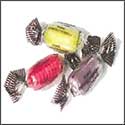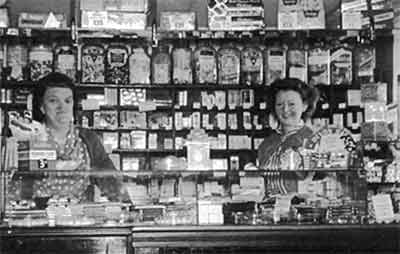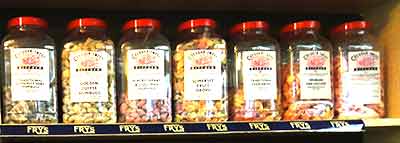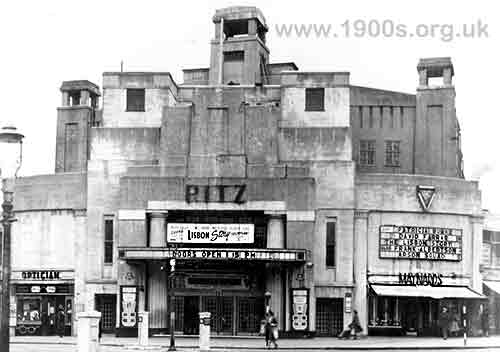Sweet shops, 1940s and 50s UK and the end of sweet rationing

Sweet shops, also known as confectioners, were few and far between in the Second World War and the years of post-war austerity. The exception was Maynards. This page explains how its location encouraged trade, the types of sweets it sold and how it sold them. The page goes on to comment of the delights and disappointments at the end of rationing.
____
By the webmaster: her early recollections with further research and contributions from others who lived at the time
Maynards sweet shops
In my childhood in the 1940s, the only sweet shop which I knew was Maynards. Not only was there one where I lived in Edgware, every other town I ever saw seemed to have one. There must of course have been other sweet shops in other parts of the country - and I would appreciate you telling me if you know of any at that time. Sweets were of course rationed. So shops specialising solely on sweets would have had a limited trade. The solution to maximising trade was in the location, as explained in the next section.
Locations of sweet shops
Maynards shops always seemed to be next to cinemas - and cinemas were extremely popular because it was a miserable time and televisions were not yet in most people's homes. These locations of these sweet shops capitalised on what seemed to be the normal expectation: that going to 'the pictures', as the cinema was called, was a treat and therefore deserving of sweets.
A Maynards sweet shop next to a cinema. It is on the far, lower right of the image.
What sweet shops sold
My mother held the family's ration books and she chose and bought my sweets. She gave me my week's supply every Sunday. Consequently I seldom went into Maynards during rationing. I do remember, though, that self-service was unknown. The assistants stood behind a counter which separated them from customers. Further back were shelves with row upon row of large glass jars of sweets and packets of other sweets and chocolate.

Inside a 1940s and 1950s sweet shop, where most sweets were weighed out for each customer from large glass jars and served in paper bags. Photo courtesy of Send and Ripley History Society.
The sweets were mainly what were known as boiled sweets because they were made by flavouring sugar water and boiling it almost dry so that the sugar was close to solidifying. Then hot liquid was poured into mouth-size moulds. All the sweets were based on sugar and the creativity of making so many different types still amazes. They were flavoured differently, coloured differently, but still essentially sugar but with different names, for example humbugs, bulls eyes, barley sugars, and many more. There were also jellies in different flavours, shaped and colours. I find them totally unappealing these days, but I suppose I must have liked them at the time.
Customers could see the sweets inside the jars and choose what they wanted.

Shelf of glass jars of sweets, photographed in Milestones Museum
The sweets were weighed out separately for each customer and sold in paper bags.
There must have been also chocolate bars, plain, milk and fille, but I remember being really taken aback when I first saw ready-wrapped bars of confectionary. Frys peppermint chocolate creams were my favourites.
I am not sure whether there were boxes of chocolates. They were certainly common before the war, but would have used a large chunk of any sweet ration.
I understand that sweet shops also sold cigarettes. Just as people expected sweets while they were watching films in cinemas, smokers expected to smoke. The cigarette smoke inside cinemas was dreadful in so many ways, but we were used to it and never questioned it.
Vending machines for chocolate bars
contributed by Douglas Adam
Chocolate bar vending machines, once full of delightful chocolate bars, stood empty until the eventual end of rationing.
The end of sweet rationing
Sweet rationing ended on 5 February 1953, i.e. nearly 14 years after the beginning of the war. I was 13 at the time and had never known sweets being off-ration. In fact, because of the continuing scarcity, sweets were still not readily available for some time.
contributed by Richard Ouston
The day after sweet rationing ended, my mother took my brother and me to a sweet shop in Edgware High Street, as it was rumoured to have a new delivery of sweets. By the time we got there, though, all that was left were a few sticks of liquorice flavoured wood chews - such disappointment after all the build up!
contributed by Albert Smith, recollection
Every sweet shop sold out of their products by midday of the first ration-free day. I was too late to spend my meagre pocket money on sweets, except for an unfamiliar packet of Maltesers. My two older sisters quickly polished off what I offered them but I left enough for myself.
Over time, most sweet shop ceased to exist as their trade was taken over by supermarkets and other shops.
| sources | webmaster | contact |
Text and images are copyright
If you can add anything to this page or provide a photo, please contact me.




